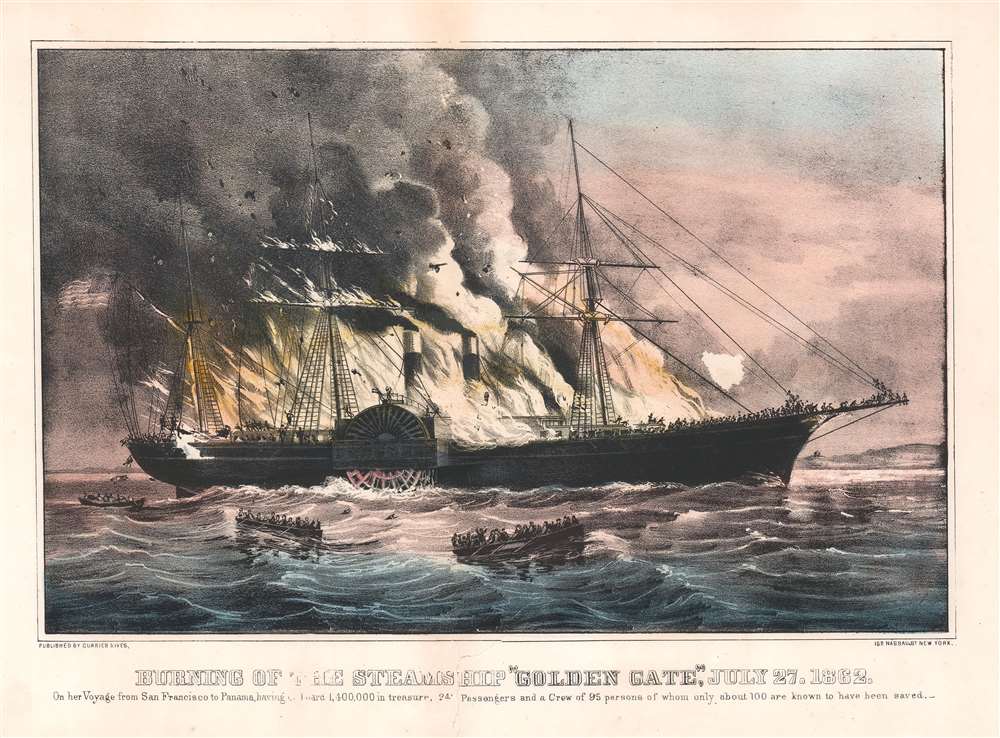This item has been sold, but you can get on the Waitlist to be notified if another example becomes available, or purchase a digital scan.
1862 Currier and Ives View of the Burning of the Steamship Golden Gate
SteamshipGoldenGate-currierives-1862
Title
1862 (undated) 9.5 x 13 in (24.13 x 33.02 cm)
Description
The S.S. Golden Gate
The S.S. Golden Gate was a steamship operated by the Pacific Mail Steamship Company. Delivered in August 1851, the S.S. Golden Gate operated on the San Francisco - Panama route from October 1851 until it sank on July 27, 1862. It was reportedly one of the most popular steamers on the Panama Route, and had a maximum capacity of 1,200 people.The Sinking of the S.S. Golden Gate
On the night of July 27, 1862, approximately fifteen miles from Manzanillo, Mexico, the crew of the Golden Gate discovered a fire in the engine room. Passengers at first sought refuge in the stern, but the fire quickly spread and they fled to the bow. The lifeboats launched in heavy surf, which led many to be crushed against the Golden Gate. Between 175 and 223 of the 338 on board were lost, along with all the mail, baggage, and the $1.4 million in cargo. In the end, only $800,000 of the gold and silver was recovered.The Pacific Mail Steamship Company
The Pacific Mail Steamship Company operated from April 18,1848 to 1949. Established to carry U.S. mail from Panama to the west coast, the company was organized after receiving the first Pacific mail contract from the U.S. government. In a fortuitous turn of events, the California Gold Rush erupted the following year, 1849, leading to boom times During the American Civil War (1861 - 1865), the steamships of the Pacific Mail Steamship Company faced threats from the Confederate Navy. Consequently, all persons boarding the ships were compelled to hand over any guns, all baggage was searched, crew members were armed, and Union soldiers sailed on most voyages. The advent of the Transcontinental Railroad severely damaged the profitability of the Pacific Mail Steamship Company, resulting in a fast decline. The company continued to exist through the 1920s, but by the late 1930s, existed only on paper. It was formally closed in 1949.Publication History and Census
This view was created and published by Currier and Ives c. 1862. We note cataloged examples at the Library of Congress, the D'Amour Museum of Fine Arts, the Huntington Library, and at the National Maritime Museum in Greenwich, England.CartographerS
Nathaniel Currier (March 27, 1813 - November 20, 1888) was an American lithographer best known as part of 'Currier and Ives'. Born in Roxbury, Massachusetts, Currier attended public schools until fifteen, when he apprenticed with the Boston lithographic firm of William and John Pendleton. The Pendletons were the first successful lithographers in the United States and were responsible for educating the next generation of lithographic printers. In 1833, Currier left the Pendleton's shop to work with M.E.D. Brown in Philadelphia. A year later, Currier moved to New York City, where he planned to start a business with John Pendleton. When Pendleton backed out, Currier found a new partner, founding 'Currier and Stodart', but the concern survived for just a year. Currier opened his own lithographic studio in 1835 as an eponymous sole-proprietorship. He initially printed the standard materials, including letterheads, sheet music, and handbills. Later in 1835, Currier began issuing current event imagery. Some of his news printers were issued in the New York Sun. By 1840, Currier had moved away from 'job printing' and further toward fine-print publishing. His Awful Conflagration of the Steam Boat 'Lexington', was published in the Sun that year, as well as being separately issued. James Ives (March 5, 1824 - January 3, 1895) began working under Currier in 1850 as a bookkeeper. Ives contributed greatly to the growth of the business, particularly as a manager, marketer, and businessman. Ives became a full partner in 1857, and the firm was renamed 'Currier and Ives'. Currier and Ives produced over 7,500 images and is best remembered for its popular art prints, particularly Christmas scenes and landscapes. They also produced banners, illustrations of current events, views, and historical scenes. Currier retired in 1880 and turned the business over to his son Edward. Currier married Eliza West Farnsworth in 1840, with whom he had one child Edward West Currier. Eliza died in 1843. Currier remarried to Lura Ormsbee in 1847. Other than being a lithographer, Currier also served as a volunteer New York City fireman during the 1850s, and he liked fast horses. More by this mapmaker...
James Merritt Ives (March 5, 1824 - January 3, 1895) was an American businessman, bookkeeper, and lithographer who oversaw the business side of the famed lithographic firm Currier and Ives. Born in New York City, Ives was a self-trained artist who began working at the age of twelve. He married Caroline Clark (1827 - 1896) on June 24, 1846, who was the sister-in-law of Nathaniel Currier's brother, Charles Currier. In 1852, Nathaniel Currier (March 27, 1813 - November 20, 1888) hired Ives as the bookkeeper for his firm N. Currier, Lithographer, on Charles's recommendation. Ives' talent for art and his knowledge of the artistic world soon became apparent to Currier, who valued his insights as well as the business acumen. Currier offered Ives a full partnership in 1857. They renamed the firm 'Currier and Ives' with Ives as the general manager. Ives began to play a role in selecting artists and prints to publish, and was responsible for pursuing publication of scenes of middle-class America that made the firm famous. After Ives died in 1895, his sons continued to work with Currier's son to manage the firm until it was liquidated in 1907. Learn More...

